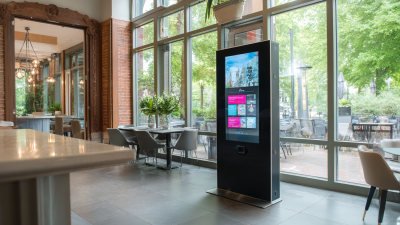The Future of Learning with Interactive Flat Panels in Modern Classrooms
Table of Contents
- Innovative Teaching Methods Enhanced by Interactive Flat Panels
- Engagement Levels: How Interactive Displays Boost Student Participation
- Data-Driven Learning: Utilizing Analytics from Flat Panel Interactions
- Collaboration in Action: Facilitating Group Work with Interactive Technology
- Accessibility Features: How Flat Panels Support Diverse Learning Needs
- FAQS
- Conclusion
- Related Posts
As educational environments continue to evolve, the integration of technology in classrooms has become paramount in enhancing the learning experience. Interactive Flat Panels are at the forefront of this transformation, offering dynamic and engaging ways for educators to connect with students. Ledersun Technology Co., Ltd., a leading supplier of LCD display technology applications, recognizes the importance of these innovative tools in modern education. Committed to providing high-quality interactive whiteboards, Ledersun aims to revolutionize both educational and conference settings, making learning more immersive and collaborative.

By incorporating Interactive Flat Panels into daily learning activities, educators can foster a more interactive, participatory atmosphere that not only captivates students' attention but also enhances their understanding and retention of information. This article delves into the future of learning with Interactive Flat Panels, exploring their benefits and potential in reshaping the educational landscape.
Innovative Teaching Methods Enhanced by Interactive Flat Panels
Interactive flat panels are transforming modern classrooms by enhancing innovative teaching methods and fostering student engagement. According to a recent survey by the International Society for Technology in Education, 67% of teachers reported that interactive displays positively impacted their ability to teach collaboratively. These panels provide an engaging platform for educators to incorporate multimedia resources, facilitating a more interactive and immersive learning experience. By utilizing features like touch capabilities and screen sharing, teachers can encourage active participation, catering to diverse learning styles and improving student comprehension.
Furthermore, a study published by the National Education Association highlighted that classrooms equipped with interactive technology saw a 30% increase in student participation rates. This technological integration allows for real-time feedback and assessment, enabling educators to adapt their teaching strategies promptly. Moreover, the rise of hybrid learning environments has further underscored the importance of interactive flat panels, as they bridge the gap between in-person and remote learning, ensuring continuity and engagement regardless of the setting. As educational institutions continue to invest in these tools, the future of learning seems increasingly interactive, fostering a generation of learners who are not just passive recipients of information but active participants in their own educational journeys.
The Impact of Interactive Flat Panels on Learning Outcomes
Engagement Levels: How Interactive Displays Boost Student Participation
In the modern educational landscape, interactive flat panels are revolutionizing the way students engage with learning materials. Unlike traditional whiteboards, these interactive displays promote a more dynamic interaction, allowing students to touch, manipulate, and collaborate on content in real-time. This hands-on approach not only captivates attention but also stimulates critical thinking and creativity, which are essential skills in today’s world. By integrating multimedia resources and interactive software, students can explore complex subjects, making learning both enjoyable and impactful.
To maximize student participation through these displays, teachers should consider incorporating a few effective tips. First, utilize collaborative tools that allow students to work in groups, encouraging peer-to-peer interactions that enhance engagement. Second, frequently switch between different types of media—videos, quizzes, and live polls—to keep the content fresh and engaging. Lastly, create a classroom culture that values every contribution by facilitating discussions that invite all voices, making students feel valued and more invested in their learning experience.
By leveraging these strategies, educators can truly harness the potential of interactive displays to foster an active learning environment.
Data-Driven Learning: Utilizing Analytics from Flat Panel Interactions
 Data-driven learning is transforming modern classrooms, particularly with the advent of interactive flat panels that provide rich interfaces for engagement. As educators adopt these technologies, they can track student interactions and leverage analytics to tailor learning experiences. Reports indicate that classrooms utilizing data-driven approaches can achieve a 20% increase in student engagement and retention rates, as teachers gain insight into individual learning patterns and preferences. This capability allows for personalized instruction, enabling educators to address each student's needs more effectively.
Data-driven learning is transforming modern classrooms, particularly with the advent of interactive flat panels that provide rich interfaces for engagement. As educators adopt these technologies, they can track student interactions and leverage analytics to tailor learning experiences. Reports indicate that classrooms utilizing data-driven approaches can achieve a 20% increase in student engagement and retention rates, as teachers gain insight into individual learning patterns and preferences. This capability allows for personalized instruction, enabling educators to address each student's needs more effectively.
Furthermore, the integration of advanced analytics not only enhances student outcomes but also provides valuable feedback for curriculum development. Research in data-driven modeling has shown that implementing machine learning techniques can improve educational strategies by predicting trends in student performance with an accuracy rate of over 85%. As we move into an increasingly tech-driven future, the collaboration of AI in educational environments will likely yield even more significant innovations, bridging gaps between traditional instruction methods and interactive, data-informed practices. Adopting these methodologies will not only prepare students for future challenges but foster a more adaptive learning ecosystem.
Collaboration in Action: Facilitating Group Work with Interactive Technology
Interactive flat panels are revolutionizing the traditional classroom, particularly by enhancing collaboration among students. Research from the International Society for Technology in Education (ISTE) indicates that 65% of teachers reported an increase in student engagement when interactive technology is used. These panels provide a dynamic platform for students to brainstorm, share ideas, and work together on projects in real-time, facilitating a more interactive learning experience.
With features like touch interactivity and the ability to connect multiple devices, interactive flat panels empower group work by allowing students to collaborate seamlessly. A survey conducted by the EdTech Digest found that 87% of educators believe that the use of collaborative technology enhances the quality of group discussions. As students engage in problem-solving and critical thinking collectively, the learning process becomes more enriching. This hands-on approach not only fosters teamwork but also builds important skills that are essential for the 21st century workforce. The shift towards interactive technology in classrooms is certainly paving the way for a more collaborative and effective education system.

Accessibility Features: How Flat Panels Support Diverse Learning Needs
The integration of interactive flat panels in modern classrooms plays a crucial role in addressing diverse learning needs, significantly enhancing accessibility for all students. According to a 2022 report from the National Center for Special Education Research, nearly 15% of public school students receive special education services. Interactive flat panels provide these students with tools that cater to various learning styles, such as kinesthetic, auditory, and visual. Their user-friendly interfaces allow educators to create engaging lesson plans that incorporate multimedia elements, making learning more inclusive.
Moreover, flat panels often feature adjustable height settings, touch recognition, and other assistive technologies that support students with physical disabilities. A study published by EdTech Magazine highlights that classrooms equipped with interactive technology can enhance student engagement by up to 40%. This increase is particularly beneficial for students with attention difficulties, as these tools offer interactive and visually stimulating environments. As educational institutions continue to prioritize inclusivity, the implementation of interactive flat panels stands out as a pivotal step towards creating accessible learning spaces that meet the needs of every student.
The Future of Learning with Interactive Flat Panels in Modern Classrooms - Accessibility Features: How Flat Panels Support Diverse Learning Needs
| Accessibility Feature | Description | Benefits | Applicable Learner Types |
|---|---|---|---|
| Screen Magnification | Allows users to zoom in on content for better visibility. | Helps visually impaired students engage with materials. | Visually Impaired, Elderly Learners |
| Text-to-Speech | Converts written text on screen into spoken words. | Supports auditory learners and those with reading difficulties. | Dyslexic, ELL (English Language Learners) |
| Touch Sensitivity | Enables interaction through touch, accommodating various input methods. | Facilitates engagement for students with limited dexterity. | Students with Autism, Physically Disabled |
| Closed Captioning | Displays text on the screen for audio content. | Enhances understanding for deaf or hard-of-hearing learners. | Deaf, Hard-of-Hearing |
| Color Contrast Options | Adjusts color settings for better visibility. | Aids learners with color blindness or visual impairments. | Color Blind, Visually Impaired |
FAQS
: Data-driven learning utilizes analytics from student interactions with technologies like interactive flat panels to tailor educational experiences, enabling personalized instruction and addressing individual student needs.
Classrooms that utilize data-driven approaches have reported a 20% increase in student engagement and retention rates, as teachers can gain insights into individual learning patterns.
The integration of advanced analytics provides valuable feedback for educators, allowing them to enhance curriculum based on data insights and trends in student performance.
Machine learning techniques can predict trends in student performance with over 85% accuracy, contributing to the refinement of educational strategies.
Interactive flat panels cater to various learning styles and provide tools for students with special education needs, creating a more inclusive learning environment.
Flat panels often have adjustable height settings, touch recognition, and other assistive technologies that support students with physical disabilities, enhancing their learning experience.
Classrooms equipped with interactive technology can enhance student engagement by up to 40%, which is especially beneficial for students with attention challenges.
Inclusive learning environments, supported by interactive flat panels, ensure that educational spaces meet the diverse needs of all students, fostering better learning outcomes.
By adopting data-driven methodologies, students are better prepared for future challenges through personalized learning experiences that promote adaptability and critical thinking skills.
The collaboration between AI and educational environments is expected to bring significant innovations, improving instructional methods and creating more effective learning practices.
Conclusion
The article "The Future of Learning with Interactive Flat Panels in Modern Classrooms" explores the transformative impact of Interactive Flat Panels on educational practices. It highlights how innovative teaching methods are enhanced by these advanced displays, fostering greater student engagement and participation in the learning process. By utilizing data analytics derived from student interactions with the Interactive Flat Panel, educators can personalize learning experiences and address individual needs effectively.
Additionally, the article discusses the importance of collaboration, showcasing how Interactive Flat Panels facilitate group work and promote teamwork in educational settings. Furthermore, it emphasizes the accessibility features of these technologies, which support diverse learning needs and ensure an inclusive environment for all students. Ledersun Technology Co., Ltd. plays a crucial role in this evolution, providing high-quality interactive whiteboards that empower both educators and learners in modern classrooms.
Related Posts
-

The Future of Display View Technology Revolutionizing Visual Experiences
-

How to Elevate Customer Engagement with Corporate Digital Signage Systems
-

Quality Products from China Leading Global Digital Signage Advertising Industry
-

The Ultimate Guide to Choosing the Best Digital Display Kiosk for Your Business
-

How to Transform Your Office Environment with Corporate Digital Signage Systems
-

Digital Interactive Signage Ultimate Guide to Engage and Inspire Your Audience
Blog Tags:





